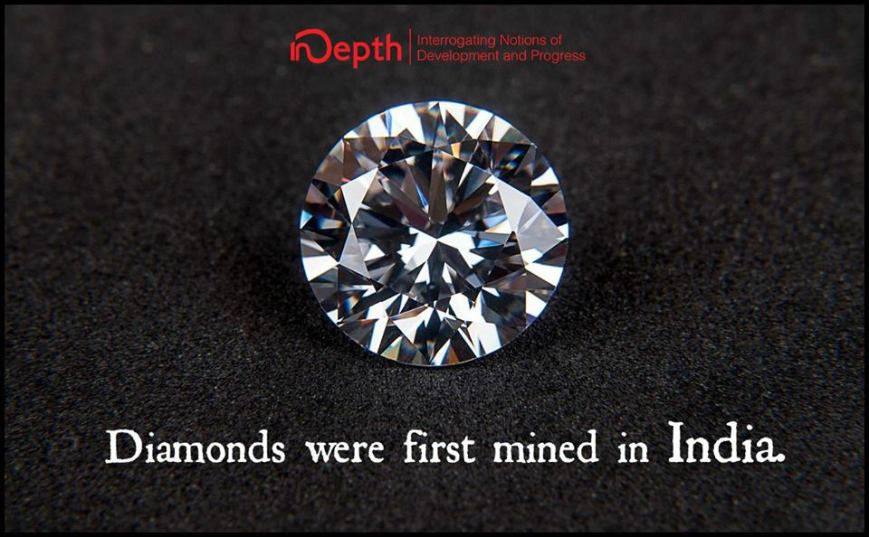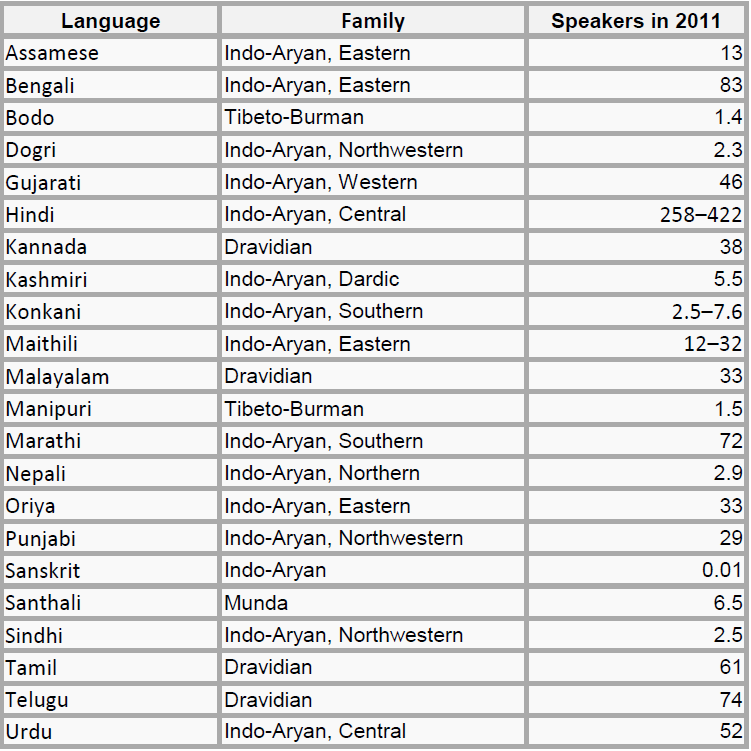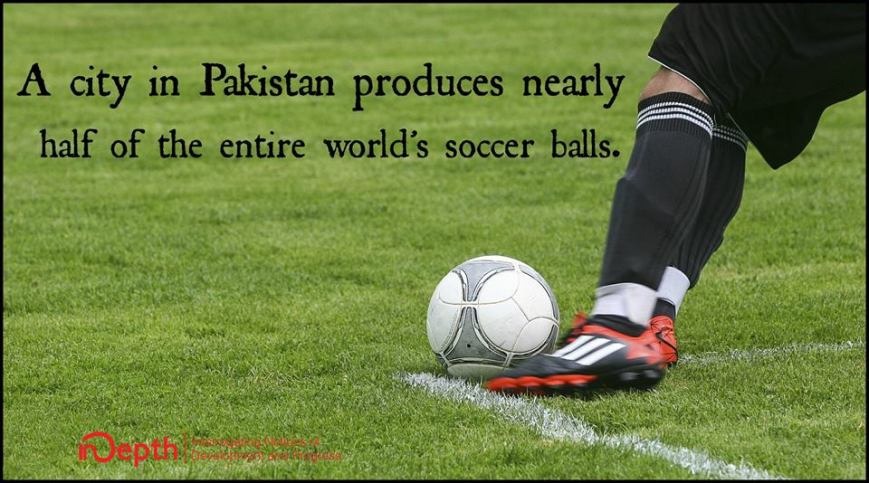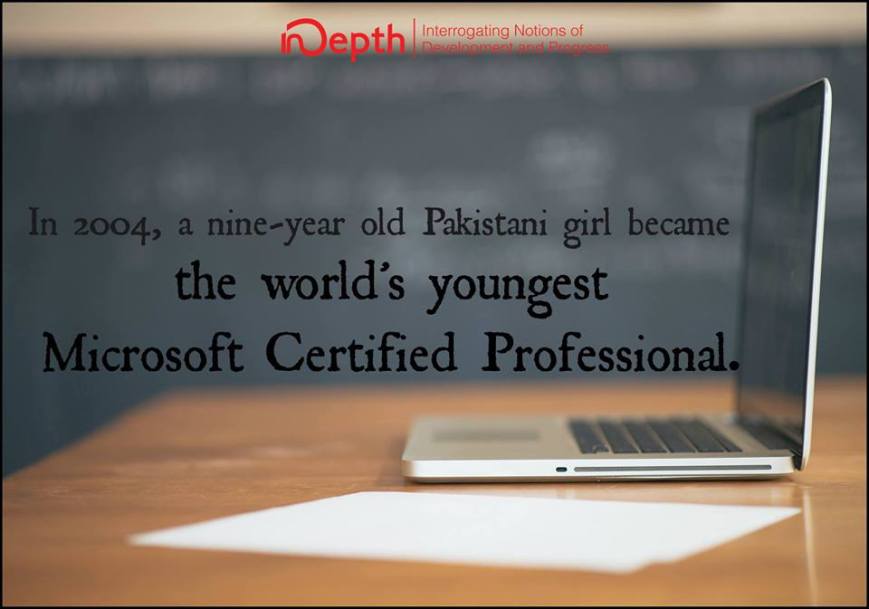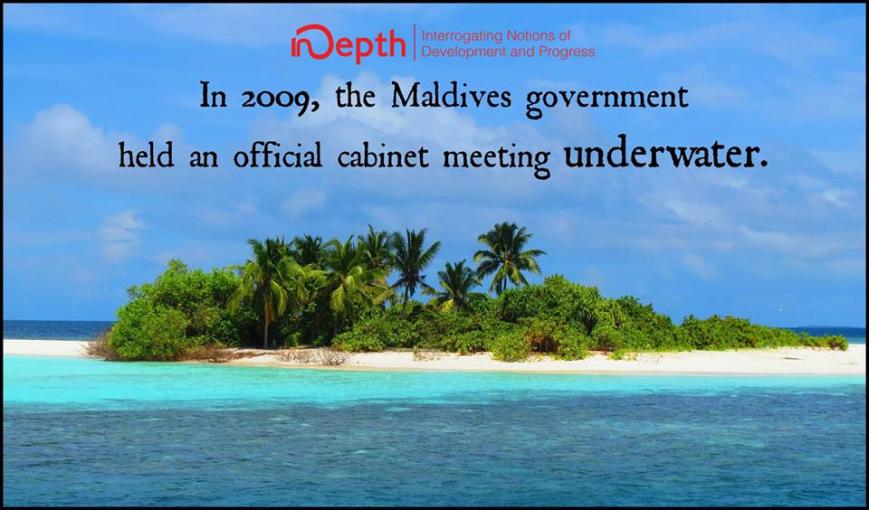22. January 30th, 2017 (India)
India…the country most of us know as home to the famous Koh-i-Noor or the Cursed Diamond. But the subcontinent’s relationship with these priceless jewels goes farther back than that.
Diamonds are believed to have first been “recognized and mined” in India. Centuries ago, the first diamonds were said to have been found in alluvium deposits along the Golconda River, among others. While the exact date of their discovery is not known, ancient artifacts from the 4th century B.C show that they quickly became a trading commodity around the subcontinent.
According to one source: “Diamonds have been known in India for at least 3,000 years but most likely 6,000 years.”
While Indians today might not be able to come across deposits of diamonds along India’s many riverbanks, centuries ago, the jewels were prized for their spiritual significance. They were thought to be a source of luck and possess a set of special healing properties to keep away ailments and illnesses.
From the banks of Indian rivers, diamonds made their way to Europe when Alexander the Great, King of the ancient Greek state Macedon, brought a batch of them back home from his expeditions in India.
Legend has it that while in India, Alexander and his army came across a deep, rocky valley whose floor was strewn with diamonds.
The valley was, however, surrounded by poisonous snakes and vicious eagles, making it difficult for anyone to reach the treasure in the middle.
Alexander devised a clever solution: from afar, he tossed chunks of meat in the centre of the valley to entice the eagles. The diamonds stuck to the chunks of meat as the eagles carried them in their beaks and flew out of the valley to consume their food, allowing Alexander and his army to catch them and retrieve the diamonds.
There is little evidence that suggests that this is a true story but it definitely made for an interesting story- we hope you enjoyed reading!
Keep up with #INDePth happenings on our social media at:
Instagram: instagram.com/indepthcon/
Twitter: twitter.com/indepthcon
#INDePth2017
By Emaan Thaver
———
21. January 27th, 2017 (India)
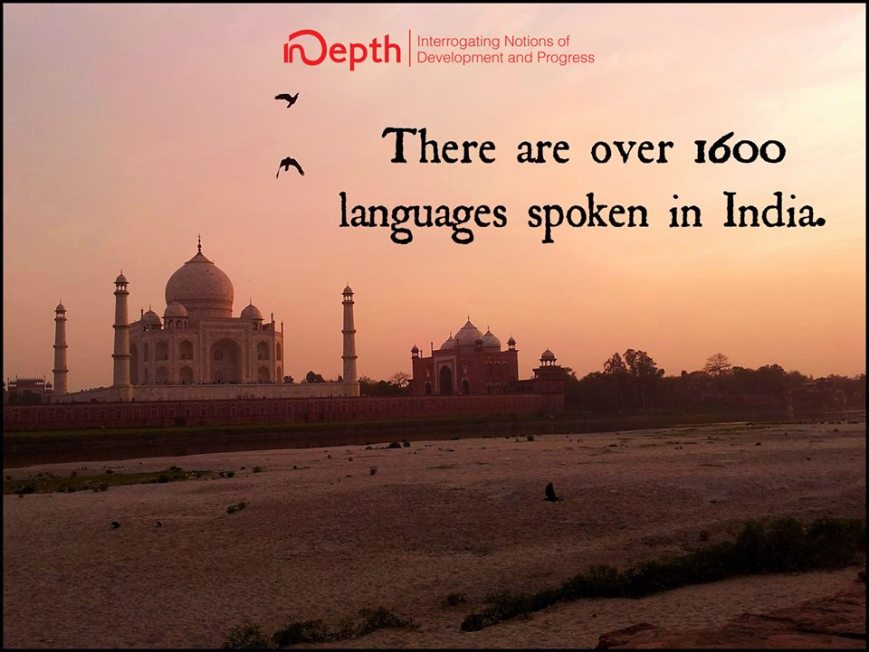
With a range of languages as diverse as its people, India boasts a fascinating array of multiculturalism within its borders.
The Census of India in 1961 identified a total of 1652 “mother tongues” spoken in the country (including languages not native to the subcontinent)
Despite Hindi and English being the two languages most closely associated with official government communication channels, the country’s more than 1 billion citizens speak a multitude of different languages, including the small sampling listed below:
We hope you enjoyed reading all about this week’s fact!
Keep up with #INDePth happenings on our social media at:
Instagram: instagram.com/indepthcon/
Twitter: twitter.com/indepthcon
#INDePth2017
By Emaan Thaver
20. January 23rd, 2017 (India)
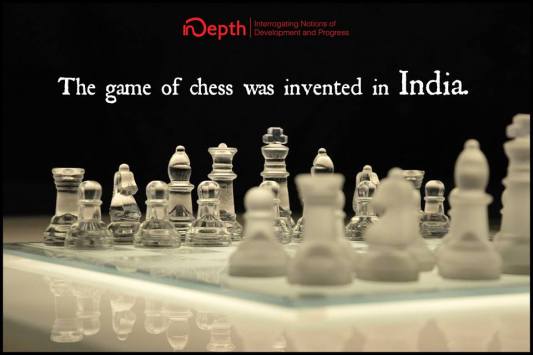
Rifle through the contents of your cupboards and you won’t be hard-pressed to find a surprising number of items that find their origins in the subcontinent.
Take shampoo, for example. The word itself comes from the Hindi word chāmpo, meaning head massage. Indians as far back as the 1500s were using an early form of shampoo to wash their hair, with the pulp of tiny red fruits called soapberries. It is said that this habit was picked up by the British when they arrived in the subcontinent and exported the practice to Europe and the rest of the Western world.
Another common object of Indian origin is the game of chess. While the black and white checkerboard we know today may not have looked quite the same way before, the game itself is said to have originated in northern India during the Gupta Empire some 1500 years back. Then called Chaturanga, the game was played with a military twist: the four pieces represented the infantry, the cavalry, elephantry and chariotry, which would later branch out into the modern-day pawn, knight, bishop and rook.
Chess then found its way into Persia and became so popular that learning to play the game was soon included in the education of Persian princes and nobles. It rapidly spread to the rest of the Muslim world after Persia, spreading to North Africa, where it was called “shaṭerej,” Russia, where it was given the name ‘shakhmaty’ and finally, Western Europe, where it evolved into the game we know and play keenly today.
We hope you enjoyed reading all about this week’s fact!
Keep up with #INDePth happenings on our social media at:
Instagram: instagram.com/indepthcon/
Twitter: twitter.com/indepthcon
#INDePth2017
By Emaan Thaver
——————
19. January 20th, 2017 (Pakistan)
Over one billion ardent soccer fans tuned in to watch the FIFA World Cup matches held across twelve different cities in Brazil, South America back in 2014. But not many may have known that the original Brazuca soccer balls used during the matches themselves were actually produced halfway across the world, in Sialkot, Pakistan!
The north-eastern city of 1.6 million has an avid sporting goods production industry, which is said to account for close to 40% of the world’s total supply of soccer balls. Sialkot produces close to 50 million soccer balls in a year!
The Forward Sports Factory in Sialkot, for example, produces most of Adidas’ leading footballs. The industry, however, has seen its fair share of controversy, particularly around child labour investigations. International organizations discovered that children as young as five years old were being made to work in factories, stitching soccer balls for up to 10 hours a day. In 1997, several of these organizations came together to implement an agreement forbidding the employment of children in these industries.
Sialkot’s relationship with soccer goes all the way back to the British Raj! Local legend has it that in 1899, a British army sergeant was playing soccer when his ball got punctured. He took the ball to a Sialkoti cobbler to get it mended and was so impressed by the quality of the repair that he immediately placed an order for a handmade batch of soccer balls. Since then, the ancient city has been the world’s go-to supplier for soccer balls and various other sporting goods.
By Emaan Thaver
We hope you enjoyed reading all about this week’s fact!
Keep up with #INDePth happenings on our social media at:
Instagram: instagram.com/indepthcon/
Twitter: twitter.com/indepthcon
#INDePth2017
——————–
18. January 16th, 2017 (Pakistan)
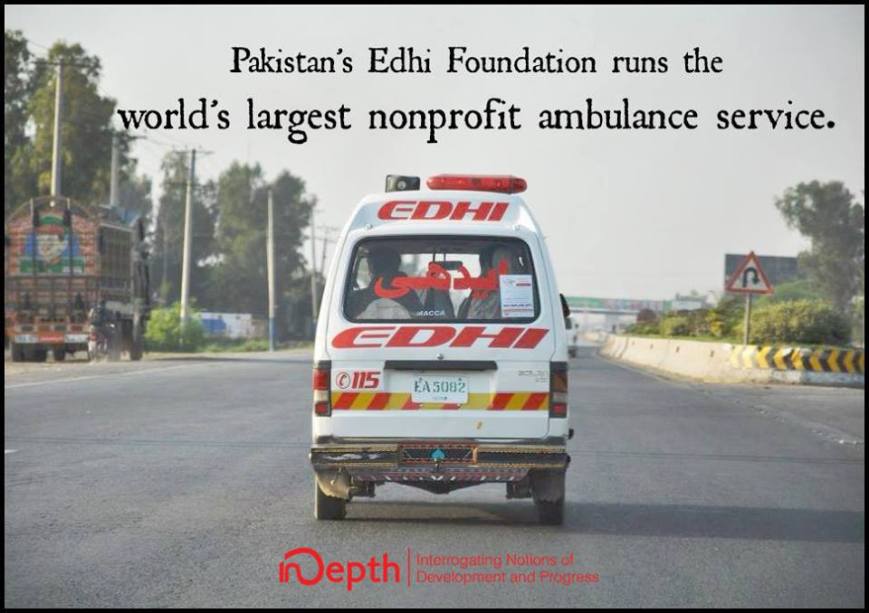
Mention the word ‘Edhi’ to anyone in Pakistan and you will almost always see eyes flash in recognition.
Abdul Sattar Edhi, sometimes referred to as Pakistan’s Mother Teresa, was one of the most revered and respected philanthropists in the country and arguably, across the globe. The 88-year old passed away in the summer of 2016, after having built a national empire of humanitarian services- ranging from hospitals to homeless shelters to rehab centres and most prominently: an ambulance service.
The Edhi Foundation runs the world’s largest ambulance service, which includes over 1,500 vehicles equipped for 24-hour emergency services: all free of cost.
The Foundation has also has run relief operations for several disaster-struck zones around the world, such as the Middle East, eastern Europe and the United States following the destruction ravaged by Hurricane Katrina in 2005.
Edhi’s desire to make a difference is said to have taken root early on in his childhood, when as a young boy, his mother would give him two coins: one to spend on himself and another for the sole purpose of awarding to the needy.
A young Edhi soon learned the importance of giving back, a lesson that took strong root when crises plagued struck his city, Karachi.
A quote on his Wikipedia page reads: “I saw people lying on the pavement … The flu had spread in Karachi, and there was no one to treat them. So I set up benches and got medical students to volunteer. I was penniless and begged for donations on the street. And people gave. I bought this 8-by-8 room to start my work.”
Despite his nationwide fame and being credited with single-handedly “changing the face of welfare in Pakistan,” Edhi never strayed far from his roots. He never awarded himself a salary from his organization’s finances and maintained a simple lifestyle- never owning more than two pairs of clothes at a time.
When he passed away in the summer of 2016, the nation was plunged into grief and mourning for a man who deeply, consistently and open-handedly gave, even when he had little to give.
We hope you found this an inspiring read to kick off your week. Stay tuned as we continue our journey through South Asia throughout this week and the next!
By Emaan Thaver
Keep up with #INDePth happenings on our social media at:
Instagram: instagram.com/indepthcon/
Twitter: twitter.com/indepthcon
#INDePth2017
——————
17. January 14th, 2017 (Pakistan)
At age nine, it is unsurprising to see children today fixated with their computer screens, engrossed in video games, YouTube channels and more.
At age nine, a young Pakistani girl called Arfa Karim, too, was immersed in the world of computers- but for quite a different reason. She wanted to study them.
Arfa later went on to become the world’s youngest computer prodigy.
She took and passed a series of examinations, earning her the title of the youngest person to become a Microsoft Certified Professional (MCP) and a meeting with the CEO of Microsoft himself, who flew her out to the company’s headquarters in the United States.
Born and raised in Faisalabad, Pakistan, Arfa had always demonstrated an aptitude for the field. After her achievement, she was awarded the President’s Award for Pride of Performance in 2005, making her the youngest ever recipient of the civil award.
She was invited to conferences, international forums, receptions with dignitaries and praised highly for her incredible feat at such a young age. At a November 2006 developers’ conference in Barcelona, the young girl was the only Pakistani in a sea of over 5000 experienced developers.
But then disaster struck. Arfa, now sixteen, was in the middle of high school in Pakistan when she suffered an epileptic seizure and then a cardiac arrest which left her fighting for her life in a critical condition. Bill Gates, the chairman of Microsoft, assembled a special panel of international physicians to monitor her case and assist with treatment plans for the teenager.
Despite showing some signs of improvement, Arfa sadly passed away in Lahore, Pakistan on January 14th, 2012.
Today marks the 5th anniversary of the bright young girl’s death. We hope that you found this an interesting read and that Arfa’s story may have inspired you to think differently and remind you that nothing should stand in the way of your dreams.
———
Keep up with #INDePth happenings on our social media at:
Instagram: instagram.com/indepthcon/
Twitter: twitter.com/indepthcon
#INDePth2017
——————
16. January 7th, 2017 (Maldives)
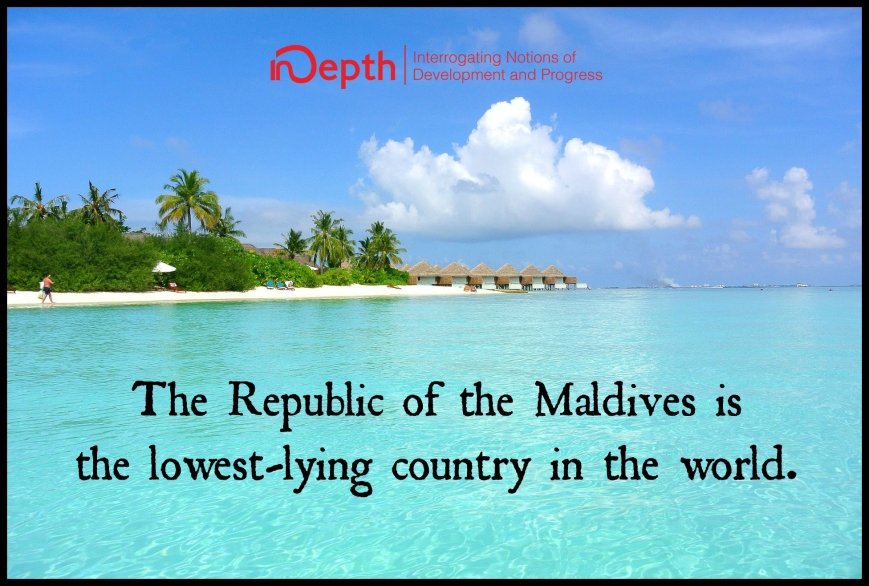
With just over 300 square km of land and approximately 350,000 people, the archipelago of the Maldives is the smallest Asian country by both size and population. The tropical atoll nation, which comprises of some 1,192 individual islands, also includes some of the lowest-lying lands on earth.
More than 80% of the country’s land is below 1.6 metres above sea level.
The Maldives has an average ground level of 1.5 metres above sea level, making it especially vulnerable to climatical changes and fluctuations in water levels.
In 2004, for example, low-lying parts of Maldives were badly hit by the tsunami that washed over South East Asia. In the aftermath of the natural disaster, 20 of the country’s islands were left completely submerged underwater.
The phenomenon of global warming, climate change and rapidly melting glaciers and icebergs have meant that the archipelago could find itself entirely submerged within the next 30 years.
We hope you enjoyed that read! Keep up with #INDePth happenings on our social media at:
Instagram: instagram.com/indepthcon/
Twitter: twitter.com/indepthcon
By Emaan Thaver
#INDePth2017
———————–
15. December 17th, 2016 (Maldives)
You might have heard of underwater weddings- but an underwater government meeting?
The archipelago of the Maldives hosted the very unusual event in October 2009: a cabinet meeting held six metres below sea level to raise awareness for climate change.
The islands’ then-president Mohammed Nasheed along with members of his executive cabinet shunned suits for scuba gear as they dove into the turquoise waters of a lagoon for a 30-minute cabinet meeting among the corals.
The seabed had been specially prepared for the occasion, with tables anchored to the bottom and attendees communicating with each other using hand signals and whiteboards. Cabinet ministers signed a document urging countries across the globe to reduce their carbon dioxide emissions and “unite in a world war effort to halt further temperature rises.”
“We have to have a better deal. We should be able to come out with an amicable understanding that everyone survives,” the document read.
“If Maldives can’t be saved today, we do not feel that there is much of a chance for the rest of the world.”
The Maldives have some of the lowest-lying lands on Earth, with 80 percent of the land area lying below 3.3 feet. The archipelago faces a very real threat from rising sea levels- with some officials back in 2009 estimating that “the whole archipelago could end up under the water by the end of the century.”
We hope you enjoyed that read! Keep up with #INDePth happenings on our social media at:
Instagram: instagram.com/indepthcon/
Twitter: twitter.com/indepthcon
By Emaan Thaver
#INDePth2017
14. December 9th, 2016 (Bhutan)
PHOTO CREDIT: Vasuki Belavadi
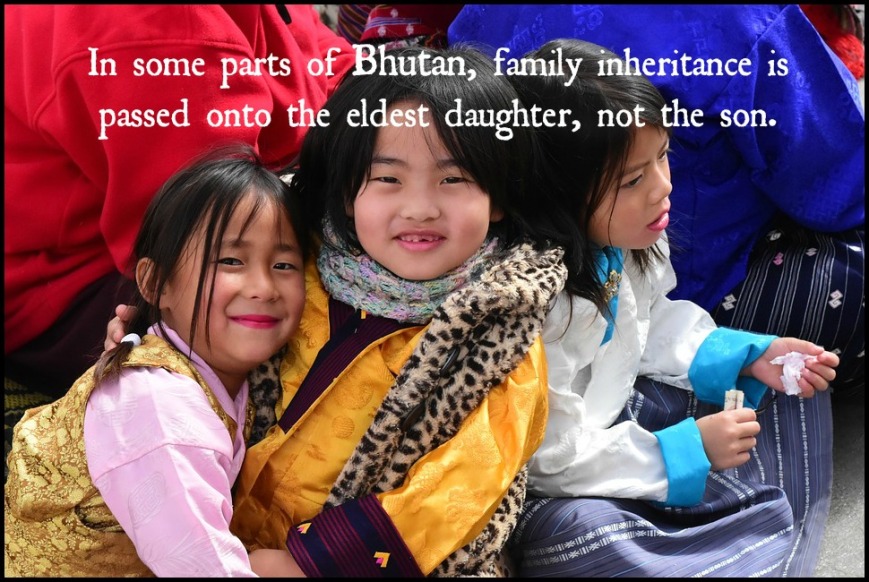
While we all may have heard of inheritance laws that favour male heirs, some communities in central Bhutan present an alternative, where the eldest daughter inherits the family’s wealth and fortunes.
It is still a tradition in certain areas to bestow the family property to the eldest daughter.
According to an article published by AFP, “women own land and inherit property, are often the family decision-makers and are even flocking to enter the traditionally male-dominated building trade.”
The article further states that Bhutan’s traditional values support equality between men and women.
“Historically men moved into their wife’s house when they got married and became part of the wife’s family,” reads a quote from the article.
“Property is very often registered in the name of the woman, because women are the ones who look after the parents in their old age. And there is no stigma attached to divorced or single women.”
A gender study carried out last year by the planning commission found that in some areas 60 percent of property is owned by women.
“Women enjoy (a) fair amount of independence in their personal, social, economic and political spheres. They are involved in decision-making processes within the household. In rural areas specially, there is sharing of productive and some reproductive tasks as well between men and women,” the report said.”
While there is no doubt much to be achieved in Bhutan and beyond in terms of gender equality, we thought it would be interesting to shed some light on the paradoxes in tradition one can find across South Asia.
We hope you enjoyed that read!
Stay tuned to our various #INDePth channels as we take on the Maldives next week!
Instagram: instagram.com/indepthcon/
Twitter: twitter.com/indepthcon
#INDePth2017
———————–
13. December 7th, 2016 (Bhutan)
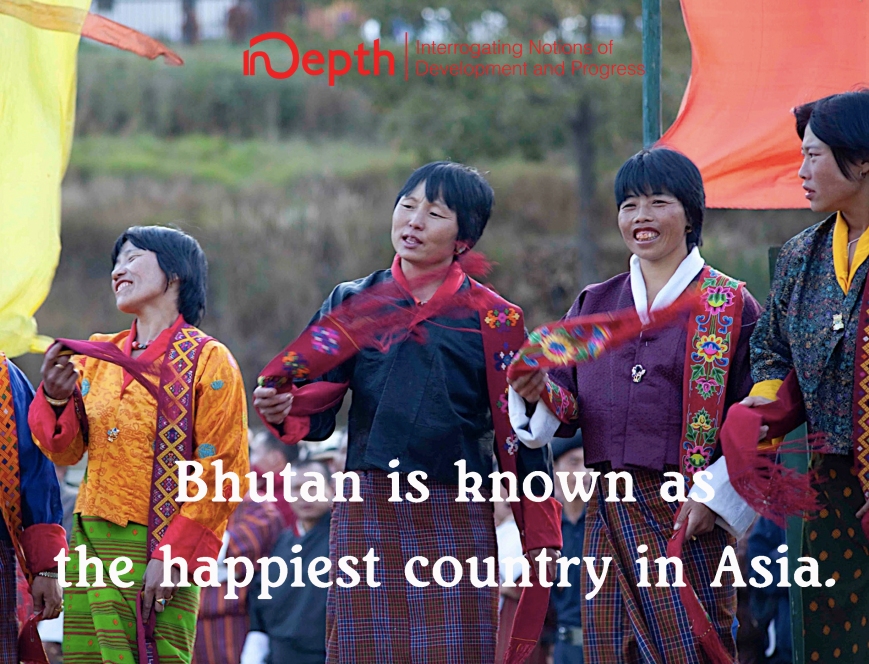
“How are you?” “Are you happy?”
These are the two most important questions that are asked in Bhutan. Since His Majesty the Fourth King of Bhutan, Jigme Singye Wangchuck, declared that materialistic abundance is not the only way to measure the national and human ‘development’, Bhutan has completely changed its way of looking at country’s ‘progress’ and ‘development’.
He believed that the Gross Domestic Product (GDP) or Gross National Product (GNP) that indicated how ‘developed’ a country is failed to measure the genuine human development because these indexes ignored the conditions of people behind ‘developing’ a country.
Instead, he challenged the globally prevailing notion that “countries with higher GDP are happier and more ‘developed’ than those with lower GDP “, and created a new indicator, Gross National Happiness (GNH) to measure the real human happiness and wellbeing.
By establishing the GNH, he announced that material progress is not the most relevant nor important indicator for human development. In other words, a country and its people can be equally happy without having the material needs and possessions as those countries with the highest GDP rates. What matters more are the health and wellbeing of people in the country, regardless of the GDP.
Bhutan has proposed nine core elements that are regarded as components to measure the GNH: psychological wellbeing, health, time use, education, cultural diversity and resilience, good governance, community vitality, ecological diversity and resilience, and living standard.
Based on these components, in 2015, 91.2% of Bhutanese are narrowly, extensively or deeply happy. (On a scale from ‘Unhappy’ to ‘Deeply Happy’, with ‘narrowly’ and ‘extensively’ happy as median indicators)
What makes you and your country happy?
#INDePth2017
By Kana Shishikura
—————————–
12. December 3rd, 2016 (Bhutan)
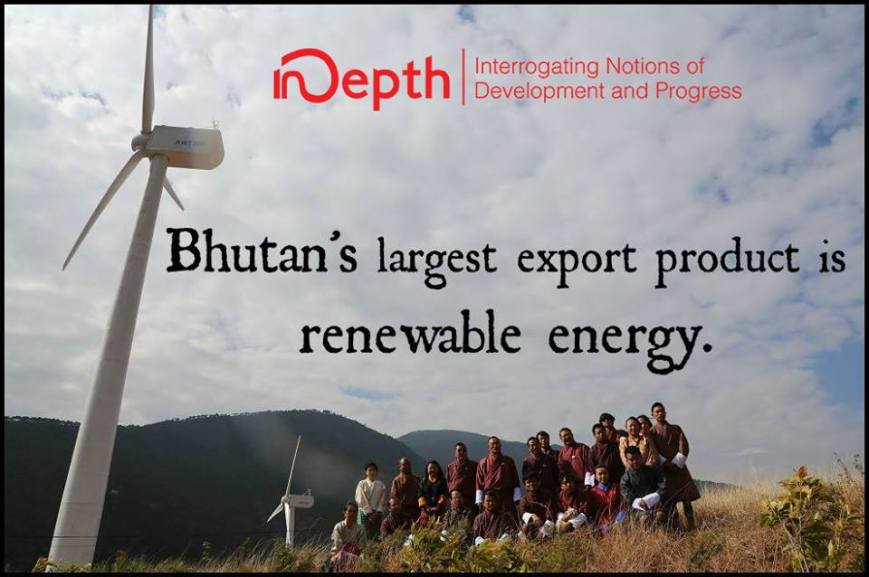
As we gear up to head on into exam season, take a little study break with us to explore the fascinating kingdom of Bhutan.
The small landlocked state is well-known in environmental circles for its dedication and commitment to green initiatives.
It remains one of the only countries in the world, for example, where citizens have a constitutional obligation to preserve and protect the environment.
Get this: plastic bags have been banned in Bhutan since 1999! The Bhutanese instead make use of cotton bags for temporary storage since they are biodegradable.
Over 72% of the country’s land is forested- in fact, its enshrined in Bhutan’s laws to ensure that at least 60% of its land is kept forested at all times.
Local animal species are also protected by the law- including the rare Bengal tiger, the red panda and the Himalayan black bear. Anyone caught killing an endangered creature faces a life sentence in prison.
Similarly, Bhutan’s efforts to reduce its carbon footprint have carried over into the workings of its energy sector: it is the only country in the world whose largest export is renewable energy.
Neighbouring India is Bhutan’s primary buyer of hydroelectric energy, which is generated through a unique turbine design that is placed into flowing rivers without the need to construct dams.
Because of its innovative approach to energy production, Bhutan has managed to maintain an overall status of being “carbon-neutral” and a net sink for greenhouse gases.
Intrigued? Keep following our social media as we take a closer look at Bhutan next week!
Don’t forget to stay updated with our Facebook, Twitter and Instagram accounts.
#INDePth2017
By Emaan Thaver
—————————————————————-
11. November 29th, 2016 (Bangladesh)
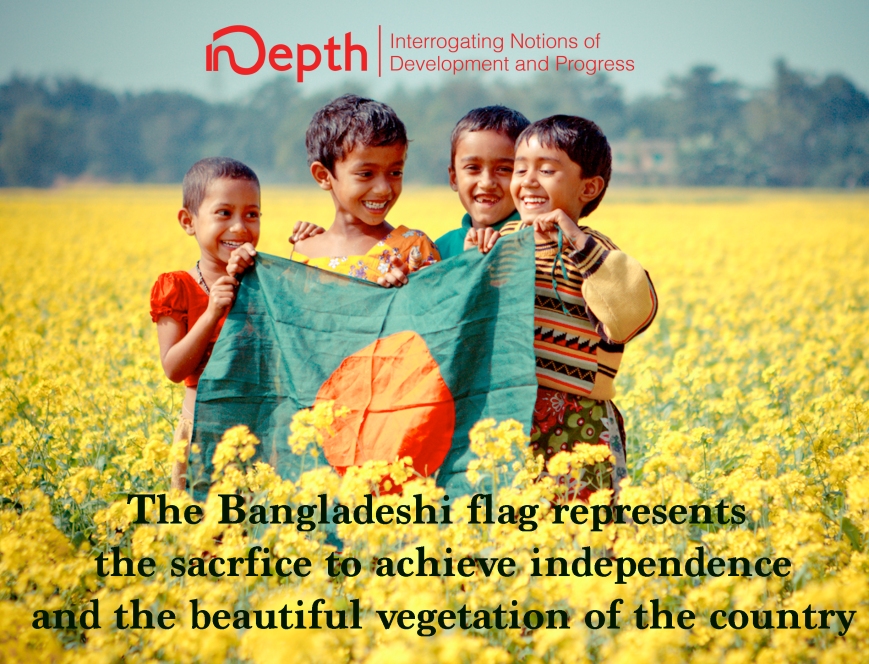
Every nation has a national flag and each flag has its unique design and stories . In the case of Bangladesh, the national flag captures the historical background and the environmental nature of the country.
The Bangladeshi flag has two colours; dark green and pure red. The red disk is located slightly to the left side from the centre.
The dark represents the villages and the breathtaking greenery that is spread across country. Bangladesh is home to many major rivers in South Asia and thus, has an ample amount of water flowing into the country. Because of the water sources coming from the river, Bangladesh has some of the most fertile delta lands in the world. Bangladesh is also famous for its mass production of tea. This is why Bangladesh has a vast vegetation throughout the country.
The red disk in the middle represents the rising sun, blood and sacrifices of people from their endeavour to gain independence after the long civil war. Bangladesh was formerly known as East Pakistan until they declared independence in 1971 after the Bangladesh Liberation War against West Pakistan. The nine-month war involved many deaths and the process of declaring independence was never easy. Therefore, the red disk serves as a reminder for the people of Bangladesh so that they won’t forget the struggle of the country.
From next week, we will be introducing you to Bhutan! Stay tuned by following us on social media. (Facebook, Twitter and Instagram)
#INDePth2017
——————————-
⑩ November 18th, 2016 (Bangladesh)
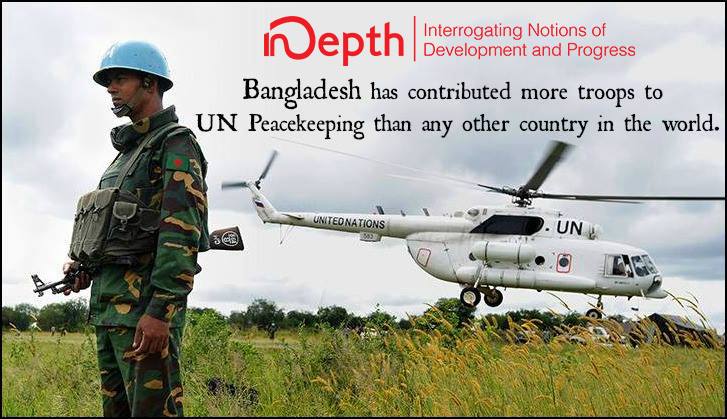
Comprised of troops from over 100 member nations, the United Nations peacekeeping force is an international body of military mediators who step in during times of political chaos around the world.
But you might be surprised to know that the majority of the personnel that make up this peacekeeping force come from South Asian nations, including India, Pakistan and Bangladesh.
Bangladesh, in particular, has contributed more troops to the United Nations’ peacekeeping operations than any country in the world; its forces make up one tenth of the UN’s entire contingent.
The country has been highly praised in the international community for its efforts. Bangladeshi troops in the UN peacekeeping forces have been consistently recognized for their devotion, dedication and discipline to the cause. Many have been honoured with commanding positions, and even train troops from other countries in the processes of peacekeeping operations.
This is not the only record that Bangladesh has set within the United Nations: in 2015, it deployed the first all-female peacekeeping unit in Haiti, which comprised over 150 female Muslim troops.
Bangladesh’s impressive contributions have made it ‘the brand name’ of UN peacekeeping forces in recent years. The country’s keen involvement in such initiatives have earned it positions in international forums and opened up discussions for the nation and the region’s role in the global movement for peace.
Stay tuned to the various #INDePth channels to learn more about Bangladesh’s cultural, social and political contributions to the international community!
By Emaan Thaver
Find us on social media at:
Instagram: instagram.com/indepthcon/
Twitter: twitter.com/indepthcon
#INDePth2017
——————————–
⑨ November 15th, 2016 (Bangladesh)
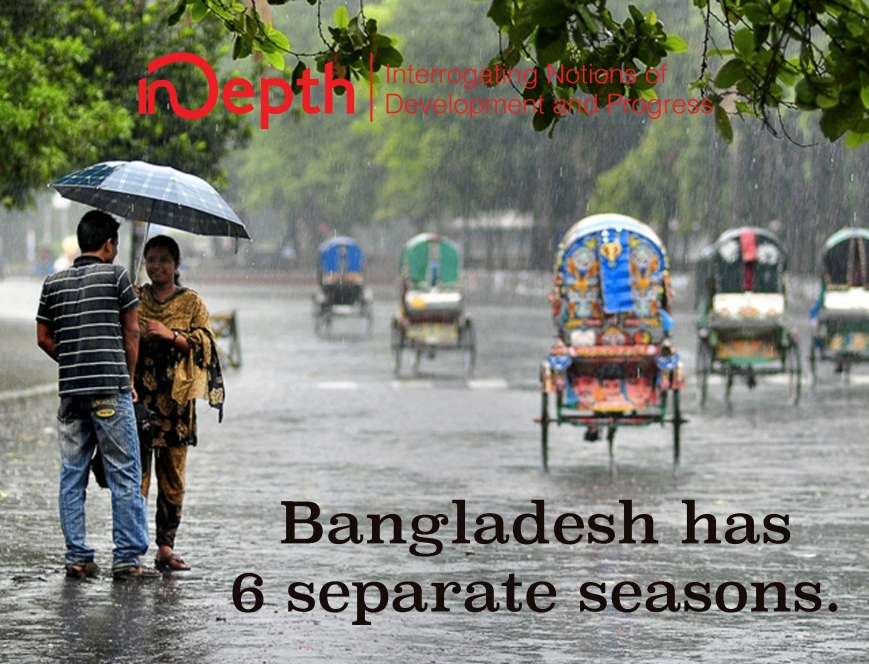
Photo By Fahim Hossain
This is our 9th edition of the Fact of the Week and in the coming weeks, we will be taking you on a journey to the unique country, Bangladesh!
Bangladesh is situated in the northern coast of Bay of Bengal and is one of the most densely populated countries in the world. It is home to more than 150 million people with rich cultural and religious exchanges. The official language, Bengali, is the seventh-most spoken language in the world and the Bangladeshi diaspora has expanded in the past decades. Bangladesh was formerly known as East Pakistan until they declared independence in 1971 after a nine-month war against West Pakistan.
Bangladesh is famous for many things but one of the unique characteristics of this country is its seasons. One year is divided into four parts in many countries but here, they subdivide its year into six parts. These seasons comprise of Grismo (summer), Barsha (rainy), Sharat (autumn), Hemanto (cool), Sheet (winter), and Bashonto (spring). This subdivision is due to the frequent change of weather, especially the high precipitation that lasts for a very long time. Bangladeshi weather is usually humid with frequent rain and the combination of tropical climate.
Natural calamities such as flooding and cyclones occur every year and supplies most of the rainfall for the rest of the year. This may seem ideal for a country that is highly dependent on agriculture; however, Bangladesh is one of the most vulnerable countries to climate change and natural catastrophes. The country has experienced one of the world’s most devastating flooding and there is an increase of people becoming climate refugees.
There are many topics to discuss about Bangladesh so make sure to stay tuned for our upcoming Fact of the Week featuring Bangladesh!
#INDePth2017
By Kana Shishikura
—————————-
⑧ November 13th, 2016 (Sri Lanka)
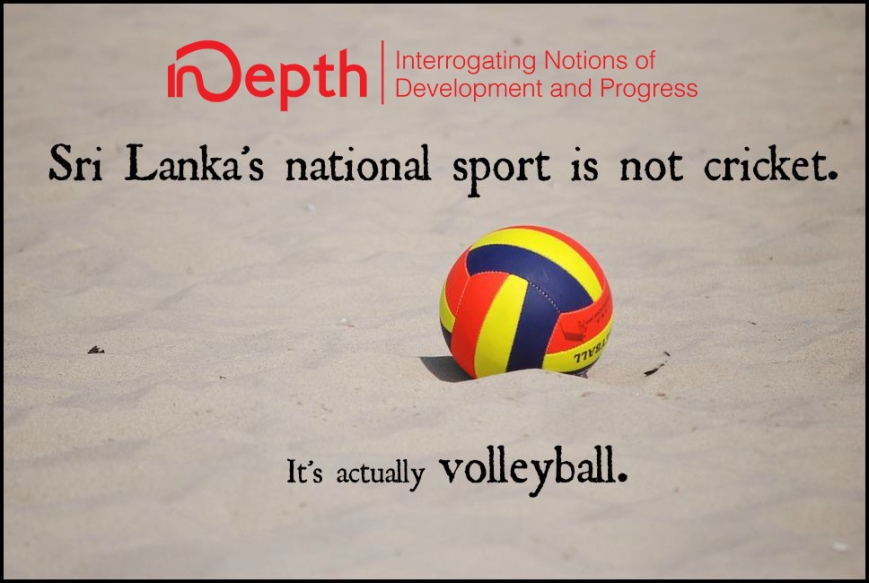
With an internationally competitive national team and a string of well-known players, Sri Lanka is no stranger to the subcontinent’s cricket fever. And yet the island-nation has chosen to give the title of its national sport to a very different game altogether: volleyball.
Known locally as Ath panda, the sport is equally popular among men and women in Sri Lanka today. Sri Lanka is also the only country in the world to recognize it as a national game.
The game of volleyball was we know it today originated Massachusetts, America in 1895. Volleyball found its way to Sri Lanka some time later- it was in 1916 that the earliest recorded reference to the sport being played in the country can be found.
According to a monthly news bulletin from the Colombo Young Members Christian Association, the sport was first introduced to Sri Lankan society by R. W. Camack, the then-Director of Physical Education at the organization. It rapidly gained popularity as teams, clubs and societies dedicated to the sport began to spring up across the island. The first national men’s volleyball tournament in Sri Lanka was held in the year 1951 and in 1991, Sri Lanka officially declared volleyball its national sport. Today, the Sri Lankan men’s national volleyball team is ranked among the top hundred in the world.
We hope you found this an interesting read. Keep up with our weekly ‘Fact of the Week’ series by following us on social media as we build up to our #INDePth2017 conference!
By Emaan Thaver
—————————
⑦ November 9th, 2016 (Sri Lanka)
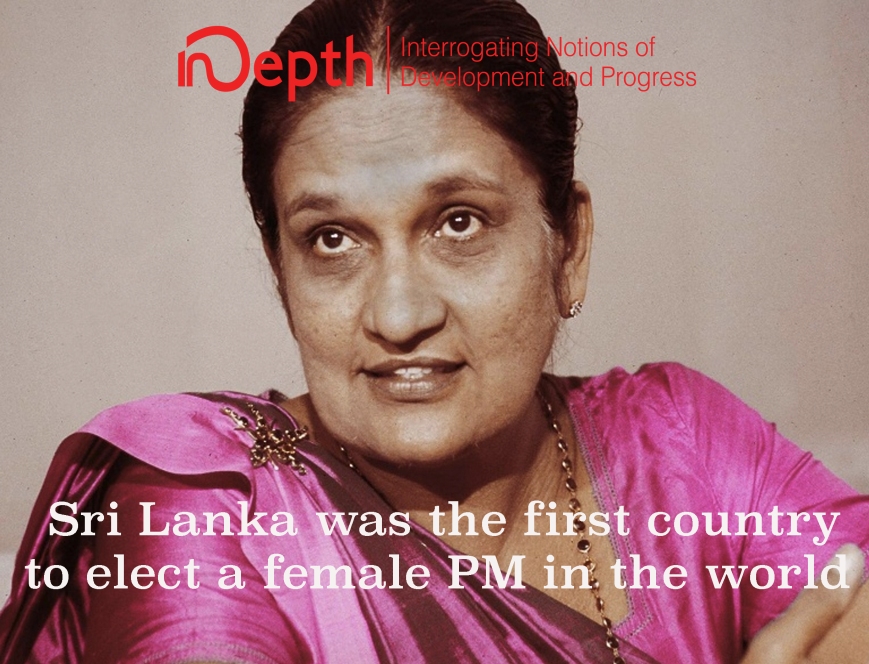
Sirimavo Bandaranaike was the first democratically elected female head of government in the world. She served as the Prime Minister of Sri Lanka three times: 1960-65, 1970-77, and 1994-2000, for 18 years in total.
Following the assassination of her husband, Solomon Bandaranaike (often referred to as S.W.R.D Bandaranaike), who was the fourth Prime Minister of Sri Lanka, the country experienced a temporary chaos and disorder. In order to continue her husband’s legacies and policies, Bandaranaike stepped into the world of politics in 1960 and was appointed as a member of the senate of Sri Lanka Freedom Party (SLFP).
One of the policies that she maintained was the Sinhala Only Act, a policy that included the repatriation of Tamils to India. Bandaranaike declared a “state of emergency” in her first year in the office due to her pursuit of Sinhala Only Act that resulted in civil disobedience campaign by the Tamils who were systematically oppressed under her power.
However, she is also credited for her intervention in the India-China border conflict in 1962 and her successful negotiation with the Indian Prime Minister, Lal Bahadur Shastri, an agreement regarding the political status of the plantation workers of Indian origin in Sri Lanka. She also pursued nonalignment agreements abroad and democratic socialism back home.
#INDePTh2017
By Kana Shishikura
——————-
⑥ November 4th, 2016 (Sri Lanka)
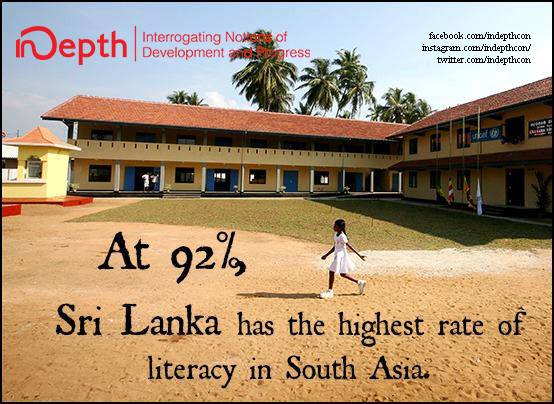
Last week, we took a look at Nepal and some of its fascinating cultural traditions.
For today’s Fact of the Week, we’re taking a trip further down south to explore the charming island-nation of Sri Lanka.
The tear-drop shaped country is home to approximately 20 million people and an array of religions, languages and distinct cultural groups. Often referred to as the ‘jewel of the Indian Ocean’, Sri Lanka’s rich historical past and equally compelling present have set it apart from other nations in the region.
For example, it was in Sri Lanka that Sirimavo Bandaranaike was elected head of the government in 1960, making her the world’s first female prime minister. With that decision, the country effectively set a standard for gender inclusivity in governance that had been unexplored even in ‘progressive’ Western societies.
The former British colony also boasts an impressive literacy rate of 92.62%, recorded in 2015.
Education has been free in Sri Lanka since the granting of universal franchise in 1931. While several educational institutions were installed by the British during the colonial period, it was actually after independence was granted in 1948 that schools rapidly multiplied across the island.
As a result, Sri Lankans today enjoy a rate of literacy that is higher than average regional and global standards.
Despite being traditionally labelled a developing country, with its exceptional record of education, modern-day Sri Lanka is challenging preconceived notions of development- which we hope you’ll also continue to question as we go through our exploration of South Asia during #INDePth2017
Stop by our website and social media next week for another South Asia-themed fact!
By Emaan Thaver
———————————–
⑤ November 2nd, 2016 (Nepal)
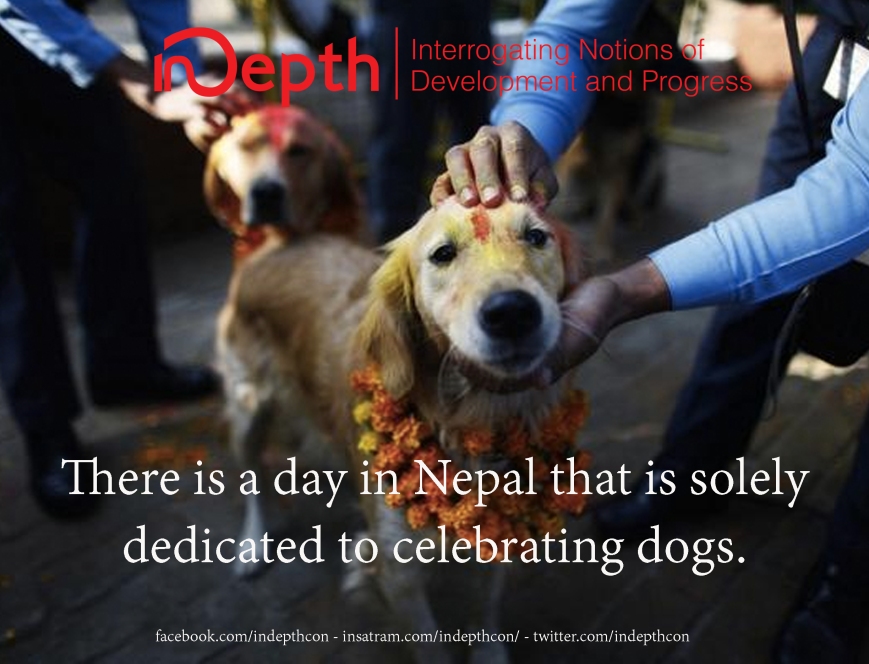
Kukur Tihar is a five-day Hindu festival celebrated in Nepal in autumn. It is a Nepali version of Diwali and it was celebrated from October 27th until November 1st this year.
During the celebration, there is a day that is solely dedicated to celebrating dogs. In Nepalese Hinduism, dogs are believed to be messengers from the god of death, Lord Yamaraj. Dogs are also represented as the path of righteousness.
Dogs are celebrated and worshipped during the celebration and all dogs, including stray, are given a red mark on their forehead to show respect and devotion. The red mark is called the Tika and it is made out of red dye powder mixed rice and yogurt.
In addition to receiving a red mark on the forehead, all dogs receive endless treats and a flower ornament draped around their neck.
On the following day, Kukur Tihar also celebrates cows as they are believed to bring prosperity to the people of Nepal.
From next week, we will be introducing you to eye-opening facts of Sri Lanka!
By Kana Shishikura
#INDePth2017
——————
④ October 28th, 2016 (Nepal)
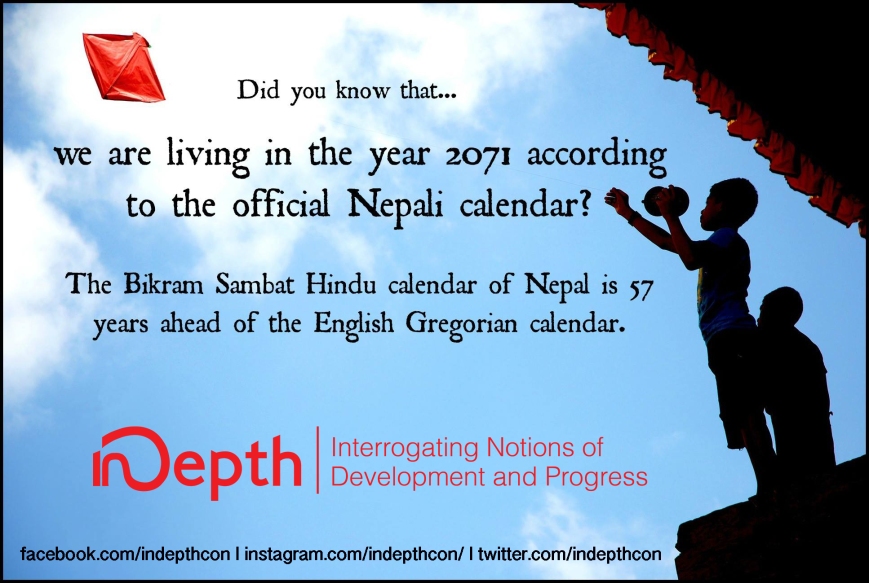
Welcome back to our fourth South-Asia themed Fact of the Week series, featuring Nepal!
One of the many fascinating things about the land-locked country of 26 million is that its national calendar is approximately 56 years and 7 months ahead of the traditional English Gregorian calendar we recognize today. This means that what we identify as the year 2016…is the year 2071 according to the Bikram Samvat calendar!
The Bikram Samvat calendar uses lunar months to format time. The length of each lunar month is determined by the time it takes the Sun to move through a full zodiac sign.
In Nepal, the new year begins in the middle of April with the commencement of a nine-day Navaratri festival season.
Stay tuned to learn more about each of the South Asian regions we’ll be exploring throughout the year!
by Emaan Thaver
#INDePth2017
—————-
③ October 21st, 2016 (Nepal)
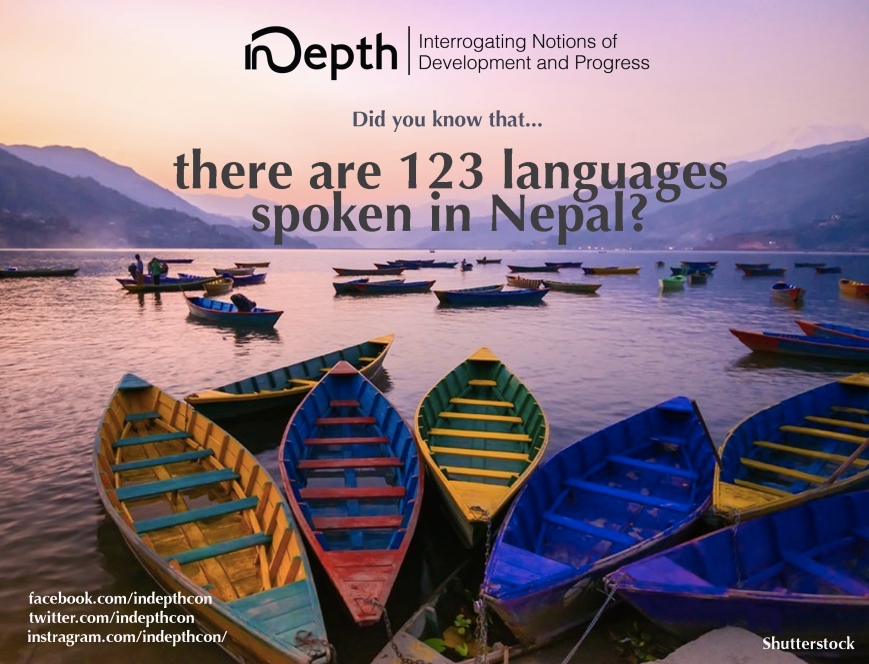
Welcome to Nepal – home to manifold cultures, languages, and ethnicities.
Although Nepal is geographically sandwiched by China and India, the two major land masses in Asia, Nepal still retains its culture distinctively of its own.
Nepal’s multiethnic and multi-dimensional heritages are manifested in diverse forms; music, art, architecture, cuisines, religion, clothing and languages.
According to the Ministry of Foreign Affairs of Nepal, as of 2011, there are 123 languages spoken in Nepal. The official language of Nepal is Nepali, which is spoken by 44.6% of the Nepali population. In addition to Nepali, the other major languages are Maithili, Bhojpuri, and Tharu. Nepal also has at least four indigenous sign languages that are preserved and used.
In the following weeks, we introduce you to this land of discovery that will sparkle your curiosity.
#INDePth2017
——————
② October 14th, 2016 (South Asia)
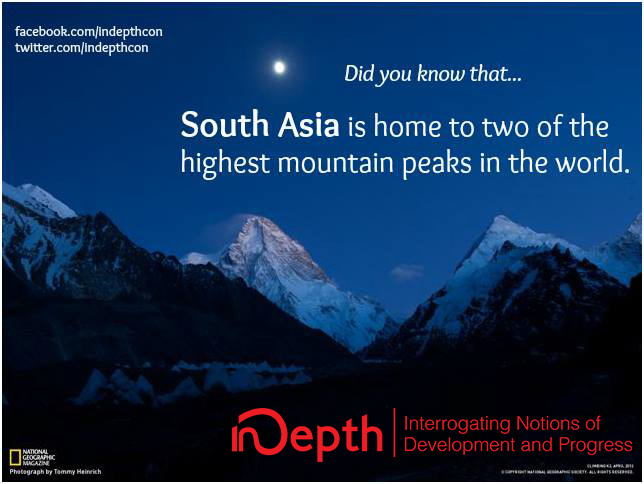
This is South Asia- a land of geographical contrasts.
Here you’ll find grasslands and glaciers, rivers and rainforests, tundras and towering mountain ranges- including two of the highest in the world.
Housed in the Himalayan ranges, Mount Everest, located in Nepal and K2, of Pakistan attract climbers, geographers and adventurers from across the globe. The infamous Everest, over 60 million years old, actually grows by a quarter of an inch every year, according to researchers. K2, while shorter, is far deadlier- the trek to her summit kills one out of every four climbers who attempt it.
Both peaks and indeed, the entire Himalayan range, are of deep significance to the South Asian region. They are an important source of agricultural productivity- their terraced slopes bear crops such as tea, rice, apples, grapes, mulberries and cherries. Dams and hydroelectric stations provide power to millions, while rivers and forests provide sources of life to numerous communities.
The Himalayan range is also a centre of spiritual interest and the site of many holy pilgrimages for Buddhists, Hindus and Sikhs. People of various cultures and religions coexist around the area in harmony. The Himalayas are one of many fascinating features of South Asia.
Stay updated to our social media accounts and our website for more insights as we head closer to conference season! #INDePth2017
By Emaan Thaver
——————
① September 30th, 2016 (South Asia)
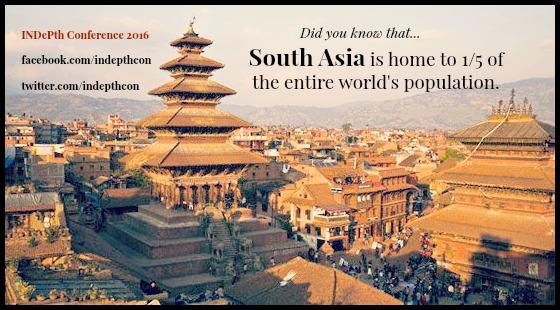
Welcome to South Asia: home to over 1.5 billion people and the most densely populated region of the world.
This busting, multidimensional group of countries stretches beyond simply the subcontinent; it includes Bangladesh and the Maldives, Sri Lanka and Nepal, Bhutan and Afghanistan. Together, the population of these states constitutes 20% of the world’s.
Shaped by a shared post-colonial experience but an array of distinct and different cultural identities, the countries that make up South Asia are a fascinating lens through which to observe development in the modern world.
This year, we invite you on a journey with us to learn about development and conflict, about progression and regression in a region that is rich in history and tradition, yet often understated and underrepresented on global platforms.
This year, we invite you on a journey to rediscover South Asia.
#INDePth2017
By Emaan Thaver
————————-

